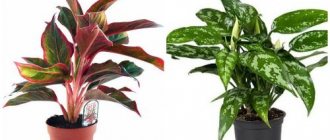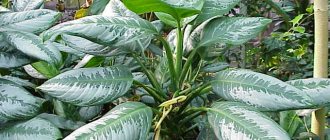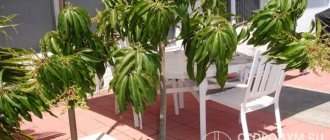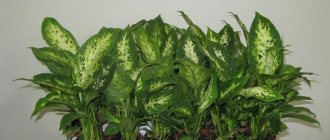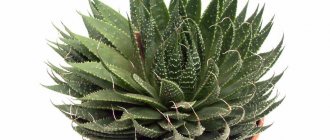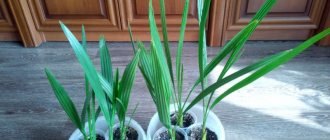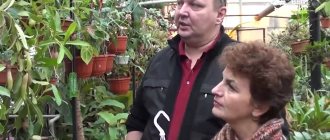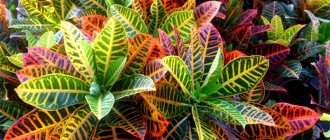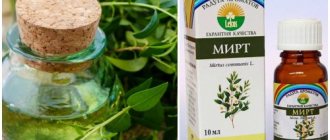Indoor plants not only serve as interior decoration, but also create a special atmosphere in the house. Many people believe that flowers grow and develop well only in an apartment with a good energy background. In fact, they require proper care and aglaonema is no exception.
In order for the plant to develop and please its owner, it is necessary to comply with growing standards. This article describes 12 basic rules that will help beginners grow a beautiful and healthy “beauty”. I tried my best for you, from my own experience, so save the page on social networks.
Transfer
Purchased specimens are replanted only after 1–2 weeks. During this period, the bush will adapt to the microclimate of the apartment, and at the same time it will pass quarantine. Transport soil is not the best environment for a seedling, but it is better to wait the allotted time and take your time.
Subsequently, aglaonema is replanted annually up to 3-4 years, older bushes once every 4-5 years.
How to understand that a flower needs a transplant:
- no annual growth;
- roots protrude above the soil surface and into drainage holes;
- water after watering does not go deep into the pot for a long time;
- the flower has a sickly, pale appearance;
- More than 4 years have passed since the transplant.
Note! The juice and berries of the plant are poisonous. When working with flowers, you must use gloves and wash your hands thoroughly.
Step by step transplant process:
- The bush is watered the day before transplanting. If a complete replacement of the soil is required, there is no need to water.
- A 2–4 cm drainage layer and a little nutritious soil mixture are poured into the new pot.
- Remove the flower from the old pot, trying not to break the earthen lump. If replacement is needed, the old soil is carefully shaken out from the roots.
- Next, install it in the center and little by little fill it with new soil.
- The pot is shaken periodically so that the soil fills all the voids.
- If support is needed, it is placed before filling the soil.
- The depth of the barrel is left at the same level.
The flower is watered and placed in partial shade for adaptation. After a week, the bush is returned to its usual place.
Two ways - two approaches
Depending on the circumstances, you can choose one of the options.
Option one - radical
You can immediately replant the flower, having previously treated it against possible pests.
To do this, use a weak solution of old laundry soap. Using a soft cloth, carefully wipe the leaves and stems with it, and after 15 minutes, rinse thoroughly.
Prepare charcoal powder, pebbles, some ordinary light flower soil and, just in case, a slightly larger pot. Carefully remove the lump of earth from the pot and inspect it.
If the roots penetrate the entire lump and rest against the walls, you need to use a larger pot. Sprinkle the damaged roots with coal powder, add drainage and a little soil, place a lump on it and sprinkle with soil.
With this method of behavior, you combine one stress that the plant has already experienced from changing its place of residence with two others: replanting and preventive treatment against pests. And then you give the plant a rest.
Just purchased aglaonema
Path of the Observer
You bring the plant home and just observe it for a while. You give him the opportunity to settle in and overcome the consequences of a change of place.
Of course, it is necessary to water and spray it regularly. After some time, you will understand how to behave with him further.
Choosing a pot and preparing the soil
A stable, wide, but not too deep pot with drainage holes and a tray is suitable for planting. Flower growers advise using containers made of plastic or coated ceramic. The diameter of the new pot should exceed the old one by only 2–3 cm.
A pot that is too large will result in the aglaonema taking a long time to grow roots, and the green mass will stop developing.
Aglaonema is undemanding to the composition of the soil, but the soil must be loose and nutritious. For planting, a purchased soil mixture for decorative foliage and bulbous plants is suitable. You can mix the soil yourself, observing the proportions.
Soil composition:
- 3 parts leaf soil;
- 1 hour humus;
- 2 parts of river sand, poured or vermiculite;
- 2 hours peat;
- charcoal.
A drainage layer of expanded clay, broken brick, polystyrene foam or small gravel must be added to the pot.
Lighting, choice of location
In its natural environment, aglaonema grows in the shade of large plants, so it is better to place the pot in partial shade in the house. The flower is light-loving, but direct rays are destructive to delicate leaves and can leave burns on them.
Note! Purchased specimens cannot be immediately placed on the windowsill. They need adaptation to natural light within 1–2 weeks.
The ideal place for the pot would be an eastern or western window sill. On the south window you will have to shade it with tulle, larger plants or place it at a short distance from the light source.
Variegated varieties turn pale from lack of light and lose color, becoming monochromatic.
Features of seasonal care
Aglaonema goes through several development phases throughout the year. There are periods of active vegetation and dormancy. Based on this, seasonal care should be adjusted.
Spring-summer period:
- temperature +22-25 degrees;
- abundant watering;
- frequent spraying;
- feeding once every 2 weeks.
Autumn-winter period:
- temperature about 16-18 degrees;
- moderate watering;
- lack of fertilizing.
Watering schedule, air humidity
Aglaonema is sensitive to the composition of water. To water it, it is better to use warm, filtered, bottled or settled water. Increased rigidity will lead to loss of decorativeness.
During the growing season, the flower is watered only when the top layer of soil has dried out 3–4 cm deep. But it is worth considering that flooding is just as harmful as drought and monitoring the condition of the earthen clod and roots. At this time, the leaves are sprayed daily, and expanded clay, pebbles or moss are poured into the tray, which are regularly moistened.
During dormancy, watering is reduced to once a week, but only if the plant is kept in a room with a temperature no higher than +16 °C. If the flower does not “fall asleep,” then the watering schedule remains the same.
How often to water aglaonema?
Aglaonema does not like flooding.
In the case of aglaonema, a simple rule applies: it is better to underfill than to overfill .
In warm, well-lit places, water when the soil in the pot dries 5-7 cm. To check, you can use special soil moisture meters, but the good old method - testing the soil by touch with your finger - works great.
If your plant is in a darker, cooler area, allow the soil ball to dry out completely between waterings.
If you are late with watering, the leaves of the aglaonema will wilt a little, this is a signal that it is definitely time to water. After watering, they quickly restore their decorative properties.
Important! If the stem has become soft, most often this is a sign of flooding rather than drying out of the plant.
Why is it better to underfill? The stems of Aglaonema are succulent and contain a large amount of moisture - this is how the plant naturally prepares for dry periods without rain. When aglaonema’s “legs” are constantly in water, and water, due to the characteristics of the plant, is constantly present in significant quantities in the stems, the flower becomes easy prey for rot. Rot develops quickly and can affect all parts of the plant.
Unregulated watering is the most common cause of problems with aglaonema.
A pot with wick watering will help you avoid it almost completely. Aglaonema will happily regulate the amount of water it needs for successful growth. All you have to do is check the water level and add it from time to time. Such a pot, by the way, also solves the question of “how to leave a plant during a vacation or business trip.” Among the budget options for wick pots, you can use the Grace flower pots - they are available in the Leroy Merlin assortment, you can also order similar options online.
You can read about the problems characteristic of aglaonema in a separate article.
Fertilizers and fertilizers
It needs to be fed only during the growing season, which lasts from March to August. Any complex composition containing nitrogen and potassium is suitable.
Note! Store-bought fertilizers often contain harmful components, so some gardeners prefer to use their own recipes .
Feeding:
- Mineral water (slightly carbonated, non-carbonated) will help nourish the flower with beneficial microelements. You can water it with soda once a week.
- Unsalted vegetable broth from any root vegetables. Can be used 2 times a week, actually replacing regular watering.
Complex mineral supplements:
- ETISSO fertilizer for indoor plants in the form of sticks. The complex contains nitrogen, phosphorus, potassium, magnesium, iron, copper, zinc. The stick is stuck into the soil and during watering it slowly dissolves and saturates the soil with useful substances. One stick is enough for a month.
- BONA FORTE is a liquid, concentrated fertilizer for decorative foliage plants. Contains phosphorus, potassium, magnesium, succinic acid, nitrogen, zinc, copper and other trace elements. For root feeding, dilute 10 ml/1.5 liters of water at the rate of 0.5 liters per bush. For spraying 5 ml/1.5 liters. The interval between procedures is 14 days.
Anti-aging pruning
As the trunk grows, it gradually becomes bare and the aglaonema loses its decorative effect. Therefore, flower growers recommend anti-aging pruning. Typically, the procedure is required for specimens older than five years.
The upper part is cut off so that all the leaves and part of the bare stem remain on it. The cut areas are dried a little, and then sprinkled with charcoal or covered with paraffin.
The hemp in the pot is covered with a bag and put in a warm, bright place until the buds appear. The bag is regularly removed and condensation is removed.
The top is rooted in soil mixture or water with stimulants. Thus, it will be possible not only to renew the old bush, but also to grow a new aglaonema.
Actually, this is how the flower reproduces. Therefore, this section will not be included, since it is simple and even a beginner can handle it. You just have to want it and you will succeed.
Formation of a spreading crown
Some new gardeners complain that their “favorite” does not branch or grow. There may be several reasons, but there are tricks that will help make the crown more luxuriant.
Recommendations:
- the pot should be tight and exceed the volume of the earthen ball by only 2–3 cm;
- pinching the upper buds stimulates the growth of lateral shoots;
- overgrown, but not very branched shoots are cut at a distance of 6–7 cm from the ground, rooted and planted next to the mother bush.
Flowering period
In the natural environment, the flowering period occurs in July or August. In apartment conditions, the bush gains color from June to September. But aglaonema is more often valued for its decorative leafy qualities. Therefore, experts advise trimming the flower stalks. Especially on young bushes.
In the process of forming buds, it spends a lot of energy, sheds its leaves, slows down its growth and may die. To prevent this from happening, the plants must be fed, the temperature maintained at the same level, and a watering and spraying schedule maintained.
Folk signs associated with aglaonema
Aglaonema is called a flower that brings good luck. This belief appeared after one person was shown the winning combination of numbers for a lottery ticket by drops of dew on a flower growing in his garden.
This flower also attracts prosperity and success in various kinds of affairs to the home. They say that if aglaonema blooms, it means that peace and comfort reigns in the family, and happy times will come for all its inhabitants.
Advice! To give a person energy and vitality, the plant should be placed on the eastern side of the house.
Knowing and following all the rules for caring for aglaonema, gardeners can easily grow this flower indoors. And it will certainly become a wonderful decoration for any home or garden.
Rest period
The dormant period of Aglaonema is weak; if the temperature in winter remains within +18-+23 °C, the plant will not “fall asleep”. In this case, there is no need to reduce watering and lighting. But it is better to postpone fertilizing until spring.
The winter dormancy period begins around October. It is necessary to gradually reduce the temperature to +14 °C, reduce watering to once a week, but at the same time regularly spray the bushes with warm water. In this condition, the pot can stand until the end of February.
It is necessary to monitor the condition of the flower and prevent the soil from drying out. If the plant begins to wither and wither, then you need to “awaken” it ahead of schedule.
Should I bathe Aglaonema or not?
Both bathing and wiping the leaves from dust will benefit the aglaonema.
Aglaonema will be happy to take water treatments once every month or two, but it is much more important to wipe off dust from the leaves , especially if the plant grows in low light conditions.
Dust prevents the effective absorption of light and, accordingly, slows down the rate of photosynthesis, as a result of which the plant obtains organic nutrients from inorganic ones. Therefore, dust literally fills his mouth.
Diseases and pests
Unfortunately, not a single flower is immune from pests. But in order to save him, it is necessary to act immediately and not postpone treatment until later. At an early stage, pests do not have time to cause significant damage, so aglaonema can and should be saved.
The scale insect can be seen without a magnifying glass. Pests look like brown bumps that cannot be removed with a fingernail. They are usually found on the inside of a leaf or stem.
| Drug name | Instructions |
| Aktellik | 1 ampoule per liter of water. Leaves are treated with the solution at the rate of 2 l/10 m². The treatment is repeated four times with an interval of 4 days. |
| Aktara | 8 g of powder per 10 liters of water, spray the resulting solution onto the leaves and stems. Repeated treatment after 4 days. |
The mealybug is localized on stems and leaves. Pest colonies resemble pieces of cotton wool or mold.
| Product name | Instructions |
| Fufanon-Nova | 2 ml/0.5 l water. Plants are treated with the solution at the rate of 1.5 l/10 m². |
| Doctor "Green Gardener's Pharmacy" | The finished briquette (arrow) is stuck into the ground at a distance of 2–4 cm from the plant stem. For a pot with a diameter of 10 cm - 2 arrows, 12–15 cm - 3 arrows. The protection lasts about 90 days. |
Aphids are small greenish insects with transparent wings.
| Drug name | Instructions |
| Fitoferm | 4 ml/500 ml water. Requires four-time treatment with breaks of 7 to 10 days. Consumption 1l/10 m². |
| Biotlin, VRK | 5 ml/10 l water. Repeated treatment after 6 days. Solution consumption 1 l/10 m². |
Spider mite
| Product name | Instructions |
| Kleschevit | 2 ml per liter of water. Three times with an interval of 10 days. |
| Augustine | 1 ml / 2.5 l of water. Four times treatment with an interval of 8-10 days. |
Varieties
Currently, several types of aglaonema are recommended for cultivation in home floriculture. Let's take a closer look at their most popular representatives:
Moderate
Another name is Modest. The plant is native to the Malay Archipelago, with some varieties found in southern Indochina.
Aglaonema moderate
This is a plant of medium height, a strand of 40-50 cm with a weakly defined central trunk. The trunk has weak branching; usually the leaves grow as if from one point. Even if you look closely, it is difficult to determine which leaf formed first.
Flower of aglaonema moderate with set fruits
It has oval, slightly elongated leaves with a pointed end. The leaves are green or dark green in color. The leaf size is average - about 17-20 cm in length and 6-10 cm in width . The leaves show several paired veins receding from the central one.
Type of plant with proper care plant
The fruits of the plant are green during ripening, and in the last month before ripening they turn red. Outwardly, they look like dogwood fruit.
Changed
This plant grows wild in the Philippine Islands and the Malay Archipelago. It has upright growing stems, the height of which depends on the growing conditions of a particular specimen. The stems are either 20 cm in height or 1.5 m.
Aglaonema modified (or changeable). Thick stem visible
The leaves of the plant are large - up to 30 cm in length and 10-12 cm in width. The color of the leaves can be varied. The leaves are rarely monochromatic, most often they are variegated, and there are both pieces of “variegation” of red and white pigments on a predominant green background, and vice versa – individual fragments of green on a common white or red.
Aglaonema variable with a predominance of white pigment
The petioles of the leaves are long and very strong. The flowering parts of the plant are collected in inflorescences of 2-6 pieces, while the spadix is relatively small and thin.
The length of the cob is usually 5-6 cm, while the length of the spathe is 7-8 cm, that is, the flower is almost completely covered from external influences. The fruits are bright red, giving the plant an additional decorative appearance.
Brilliant
Originates from Thailand or Sumatra. In the wild, it prefers damp forests or lowland plains. The plant is tall - stems and leaves can reach a height of up to 1 m. The color of the leaves is replete with shades of green.
Aglaonema splendor
The plant got its name from the shiny upper part of the leaves. Their sizes are quite large: length up to 50 cm, width up to 20 cm. Flowers are collected in inflorescences of 2-5 pieces. The cob is completely covered with a blanket and is practically invisible. The fruits ripen by March. Their color is bright white.
The plant requires special care because it needs diffused sunlight. On the other hand, its size is quite large, so flower growers recommend devoting one of the entire windows to Aglaonema lucidum . Moreover, the gardener should not be embarrassed by the small growth of the plant: with proper care, in 2-3 years it will occupy the entire area in front of this window.
Ribbed
Originates from South West Malaysia. It is a herbaceous plant with a low stem, abundantly branched at the base.
Aglaonema ribbed
The leaves are oblong, pointed at the end. Their length reaches 20-25 cm, width 5-10 cm. They are quite strong, one might say, rigid. The color is almost always dark green with many white streaks and spots located on top. The lower part of the leaf partially repeats the color of the upper part, but there are significantly fewer spots.
Painted
This plant is native to the jungles of Sumatra and Borneo. The plant is medium in size, its height rarely exceeds 60 cm. It has a weakly defined “trunk”, strongly branched from below. The shoots are densely covered with leaves. The color of this aglaonema is a very characteristic three-color, reminiscent of some types of military camouflage.
Aglaonema painted
The leaves are small, about 10-18 cm long and 5-6 cm wide. Pigment spots are distributed evenly across the leaf, but the intensity of the color depends on the place where the plant lives. In more illuminated areas, the colors are more faded, in shaded areas they are brighter.
Aglaonema painted with elongated leaves
The fruits of the plant are located, as a rule, on stems raised above the leaf mass by 5-6 cm. They are bright red, very decorative and clearly visible from afar.
Oblong
Another name is oblong-leaved. Comes from the Philippine Islands. It has green or white-green oblong leaves. Their length is about 30 cm, and their width is no more than 5 cm. The petioles of the plant are also long, about 20-25 cm.
Aglaonema oblongata
It has the most elongated leaves (in relative proportions) , which, taking into account the length of the petiole, creates the illusion of very long shoots, which is often used in design.
Usually, a pot with Aglaonema oblongata is placed on a separate stand to enhance the effect.
Errors
Aglaonema is a fairly resilient plant that rarely gets sick (it’s not for nothing that it’s Leon’s favorite from the movie of the same name). In most cases, problems with flowers occur due to mistakes by flower growers, as well as non-compliance with care rules.
| Symptoms (signs) | Causes | Recommendations |
| Rotting of the stem and roots | Stagnation of moisture at the roots due to excessive watering and lack of drainage holes in the bottom of the pot. And also due to freezing of the root | If not only part of the stem is affected, but also the roots, then the plant cannot be saved. The tops of the bush are cut off “alive”. The roots are thrown away along with the soil, and the cuttings are rooted |
| Leaves are rich in color, lose their variegation of color, turn pale | Lack of nutrients, lack of lighting | Adjust the feeding schedule during the growing season and move the pot to a lighted windowsill. In winter, you can install a special lamp |
| The tips of the leaf blades darken and dry out | Lack of humidity | The plant is removed away from heating devices and sprayed daily with a spray bottle. An automatic humidifier, a glass of water on the windowsill, or wet moss in a tray can increase humidity. |
| Leaf blades curl and turn black | Low temperature, high humidity, cold draft | The pot is transferred to a warm room where there is no draft |
| Pale yellow spots appear on the leaf blades | Sunburn | The flower is removed from the sun and placed in diffuse partial shade |
| There are small dark spots with a vague outline on the leaves | Watering with hard or cold water | The flower is transferred to watering with settled, filtered or bottled water. As a preventive measure, water with an aqueous solution of citric acid at the rate of 0.2 g/10 l for a week. |
| The lower leaves turn yellow and fall off | This is a natural process, but only if the phenomenon does not become widespread | Care does not change. If the plant has lost its decorative appearance due to a bare trunk, rejuvenating pruning is carried out |
| The edges of the leaves dry out, the plate becomes deformed | Insufficient watering | Reduce the interval between waterings |
| New leaves are small, faded and weakened | Lack of nutrition, possibly cramped potty | If necessary, the flower is replanted and complex fertilizer is applied. |
| Transparent drops form at the tip of the leaf blades | High air humidity or excessive watering | The plant gets rid of excess moisture, so it is necessary to review the watering schedule and measure the humidity |
| Slow development, complete cessation of growth | Lack of nutrients, cramped pot, low temperature, poor lighting and watering | This is a slow-growing plant, therefore, if there are no obvious violations, adjustment is not required |
Description of the plant
Aglaonema is a genus of plants in the Araceae family, which includes 23 species native to tropical regions of Southeast Asia, from India to Papua New Guinea. Many years ago, Aglaonema came to us from the Asian tropical forests, where it grows in dense forests and protects its foliage from the scorching sun under the trees. It settled in easily with us and, thanks to its ability to adapt to more difficult lighting conditions, it grows even in the shadiest corners of the house, tolerates dimly lit positions well, but must be protected from direct contact with the sun.
The scientific name Aglaonema comes from the Greek words - αγλαός (aglaos - bright, beautiful) and νήμα (nema - nothing). The name refers to the structure of the plant's male flowers.
Aglaonema blooms from spring to late summer. The aglaonema flower is truly unusual, typical of representatives of the Araceae family, that is, similar to the flowers of spathiphyllum or anthurium. It is shaped like a spadix and is most often white, although some varieties have yellow flowers. The lower part of the cob is tightly “wrapped” with sepals. Over time, red or yellow fruits – berries – are formed from inconspicuous flowers.
All species have lanceolate leaves, which are usually quite decorative, which is why they are so popular. Leaves can have different colors.
Plant species
The genus Aglaonema includes 23 species, but only a few of them are grown in our country.
Popular types:
- Aglaonema commutatum is most often found indoors at home. Plants often have bicolor leaves, green with greyish patterns. Breeders have developed numerous varieties with interesting and varied colors of leaf blades.
- Aglaonema crispum - gray leaves with dark green edges.
- A. round (A. Rotundum) - green leaves with red veins.
- A. ribbed (A. Costantum) - the leaf is decorated with white veins.
The most popular potted plants are those with large decorative leaves. Among the most beautiful and frequently grown is the Variable Aglaonema (Aglaonema commutatum). This is a real gem among plants grown at home. Its cultivation will be discussed further.
Aglaonema crispum - description
In its natural environment, modified aglaonema forms a trunk and can reach a height of 2 meters. In apartments it rarely reaches 80 cm. It usually has a bush form - it consists of stems on which magnificent leaves appear. The leaves are borne on long petioles and grow on a tough, tall, unbranched stem, but they first form a beautiful tuft just above the ground.
The leaves are large, oval and elongated, rather thick and fleshy, slightly raised. They are slightly reminiscent of Dieffenbachia leaves, but are more attractive due to the decorative spots on both sides of the leaf blade. Aglaonema is very decorative precisely because of the silvery stripes that add attractiveness to the leaves.
Aglaonemas sometimes bloom in apartments; they produce a rather interesting inflorescence, which does not have any special decorative qualities. White or yellow flowers are inconspicuous, surrounded by green foliage, collected in flasks, completely odorless. Sometimes the plant bears fruit, producing red berries.
Photo. How aglaonema blooms at home
Attention! Aglaonema is highly poisonous. Its juice irritates the skin, so plants should remain out of the reach of children and cats. Poisoning can result in paralysis of the nervous system, and the risk of death is quite high. It should not be planted in herbivore terrariums.
Popular varieties
Aglaonema modified has been subjected to selection and received interesting varieties that cope better with home growing conditions. The latter options are most resistant to dry air, so central heating does not bother them.
The most popular varieties:
- "Silver Queen" Sliver Queen is the most popular variety with unusual leaves, almost entirely silver with green veins.
- “Crete” Crete is an aglaonema variety whose care should take into account varietal characteristics - red varieties are more demanding on lighting than green ones. Crete is a variety with variegated green leaf blades covered with intense pink-red spots, a pink-red rim and main vein. If there is not enough light, the leaves will turn green.
- "Fest Diamond" First Diamond is a variety with creamy green leaves.
- “Prestige” Prestige is green with numerous large pink spots.
- Aglaonema "Silver Bay" Silver Bay - green leaf blades with a large silvery-white spot in the center and light spots on the sides.
- "White Lance" White Lance - leaves are elongated, narrow, thin, with an elongated silver-white spot in the center and a green rim.
- "Bloody Mary" Blood Mary is a variety with intensely colored leaves of a dark red color and a small amount of green at the ends of the leaf blade.
- "Red Elephant" Red Elephant - the leaves are painted in an intense crimson-pink color, the green color is visible only in the form of irregular coloring of the edges of the leaf blade and sometimes in the middle.
- "Green Bowl" Green Bowl is a rare variety, has large leaves, concave, like gutters, and a very compact shape. The leaves are decorated with three shades of green.
- “White Kiwi” White Kiwi is a variety with small, tightly adjacent leaves, compact. Green edges and spots on creamy interior of leaves.
- "Butterfly" Butterfly - leaves are variegated, pink and green.
- "Anyamanee Tricolor" Anyamanee Tricolor - the leaves of the variety are large, oval, variegated, they look as if someone painted them green, red and yellow. The spots are irregular and of different sizes. Collection variety.
- "Amelia" is a variety with elongated leaves with white veins.
- "Anyamanee Red" Anyamanee Red is a variety with a bright pink leaf blade with decorative green-yellow spots.
- “Stripes” Stripes - the variety became popular after the release of the film “Leon the Killer”. A beauty with dark green large leaves and decorative silver-gray stripes.
Photo. Aglaonema variety Stripes in the film “Leon the Killer”
